Advance in Accounting Project: Tobacco Industry CSR Analysis
VerifiedAdded on 2020/05/16
|19
|5315
|61
Project
AI Summary
This project delves into the corporate social responsibility (CSR) practices of the tobacco industry, examining how these companies manage their image and address criticisms. It explores the industry's strategies, including public relations efforts, in response to being labeled as producing 'evil' products, and how they attempt to align with CSR standards. The project investigates the research questions of how these companies maintain socially responsible standards and whether the CSR strategies are genuine or misleading. The study uses secondary data to analyze the credibility of CSR policies, challenges in implementation, and the impact of these activities on corporate image, considering both short-term and long-term effects. The research methodology includes descriptive design and case study analysis, utilizing both quantitative and qualitative analysis techniques. The project also considers the role of the World Health Organization (WHO) and the inherent contradictions in the tobacco industry's CSR efforts, especially in the context of public health objectives. The analysis examines the significance of CSR policies, challenges faced, and ways in which effective CSR policies can benefit or introduce alterations in a tobacco industry.
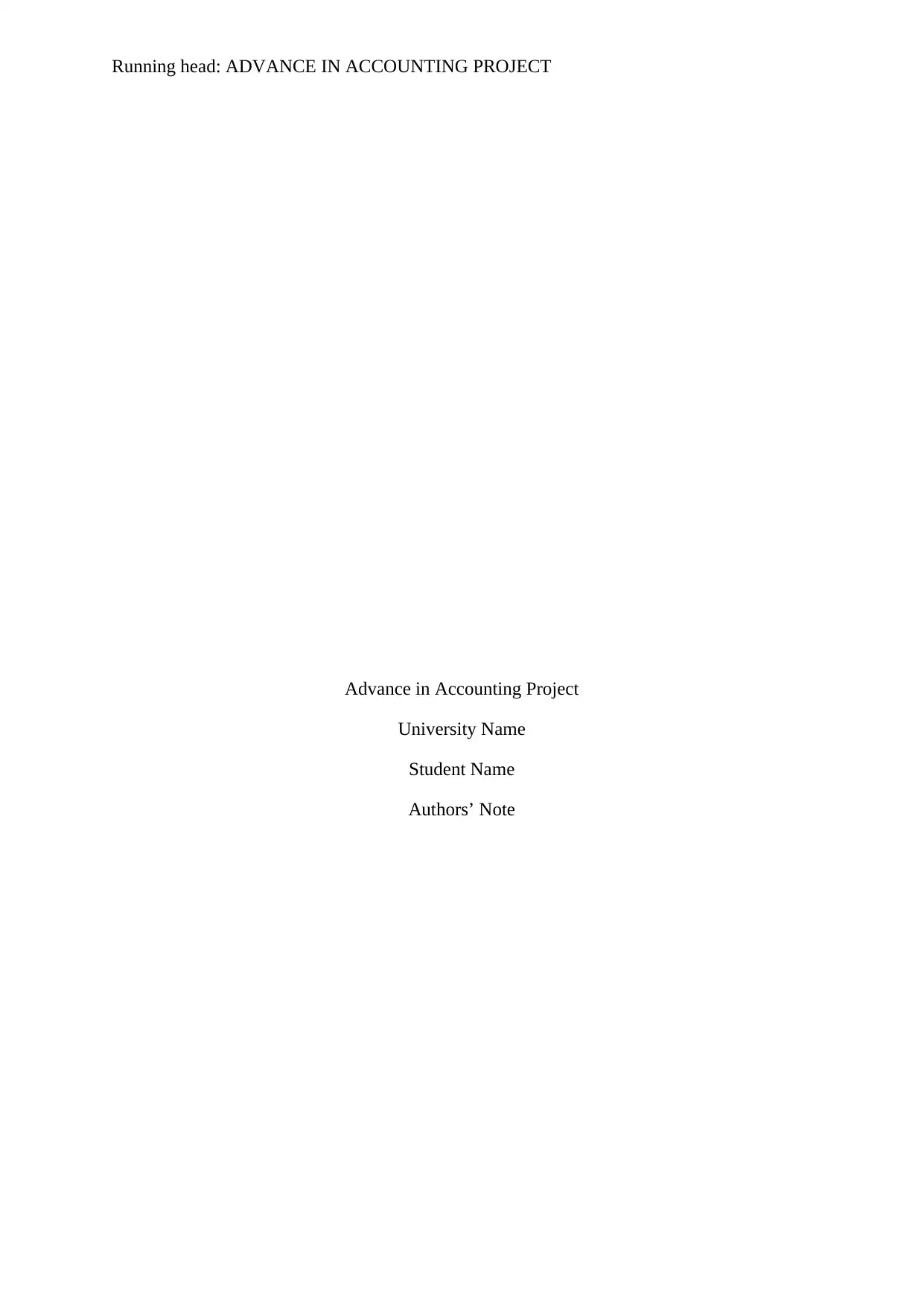
Running head: ADVANCE IN ACCOUNTING PROJECT
Advance in Accounting Project
University Name
Student Name
Authors’ Note
Advance in Accounting Project
University Name
Student Name
Authors’ Note
Paraphrase This Document
Need a fresh take? Get an instant paraphrase of this document with our AI Paraphraser
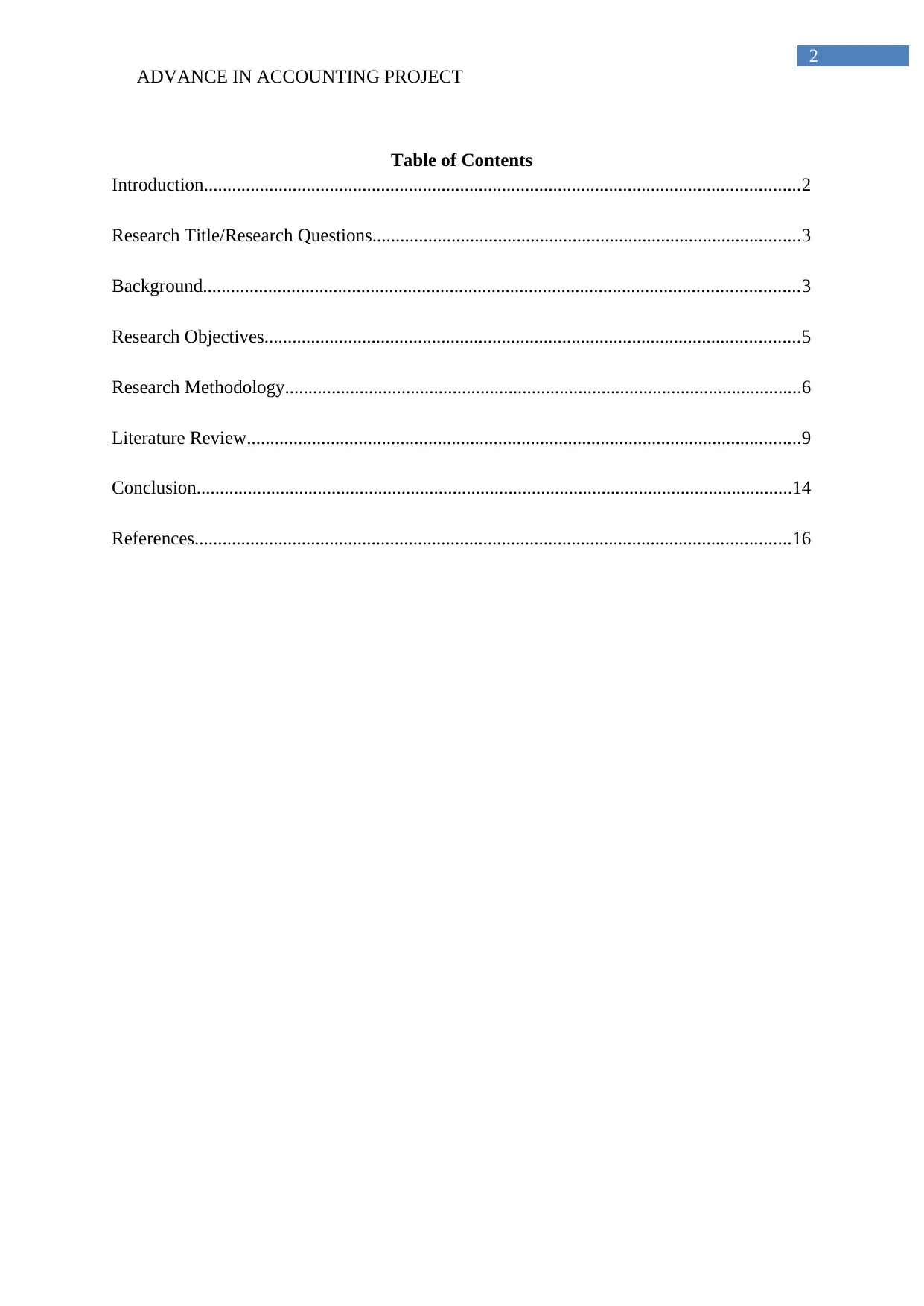
2
ADVANCE IN ACCOUNTING PROJECT
Table of Contents
Introduction................................................................................................................................2
Research Title/Research Questions............................................................................................3
Background................................................................................................................................3
Research Objectives...................................................................................................................5
Research Methodology...............................................................................................................6
Literature Review.......................................................................................................................9
Conclusion................................................................................................................................14
References................................................................................................................................16
ADVANCE IN ACCOUNTING PROJECT
Table of Contents
Introduction................................................................................................................................2
Research Title/Research Questions............................................................................................3
Background................................................................................................................................3
Research Objectives...................................................................................................................5
Research Methodology...............................................................................................................6
Literature Review.......................................................................................................................9
Conclusion................................................................................................................................14
References................................................................................................................................16
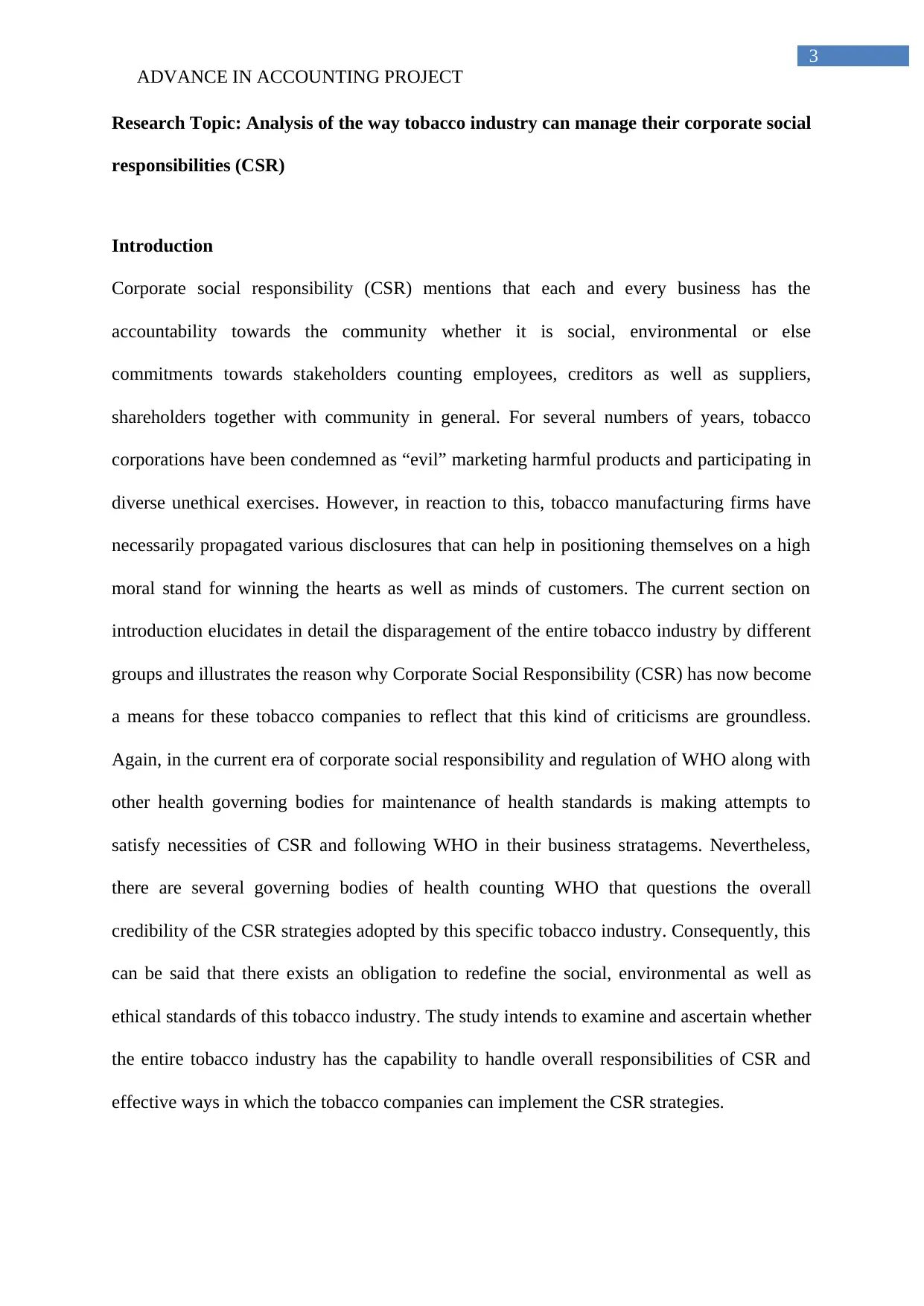
3
ADVANCE IN ACCOUNTING PROJECT
Research Topic: Analysis of the way tobacco industry can manage their corporate social
responsibilities (CSR)
Introduction
Corporate social responsibility (CSR) mentions that each and every business has the
accountability towards the community whether it is social, environmental or else
commitments towards stakeholders counting employees, creditors as well as suppliers,
shareholders together with community in general. For several numbers of years, tobacco
corporations have been condemned as “evil” marketing harmful products and participating in
diverse unethical exercises. However, in reaction to this, tobacco manufacturing firms have
necessarily propagated various disclosures that can help in positioning themselves on a high
moral stand for winning the hearts as well as minds of customers. The current section on
introduction elucidates in detail the disparagement of the entire tobacco industry by different
groups and illustrates the reason why Corporate Social Responsibility (CSR) has now become
a means for these tobacco companies to reflect that this kind of criticisms are groundless.
Again, in the current era of corporate social responsibility and regulation of WHO along with
other health governing bodies for maintenance of health standards is making attempts to
satisfy necessities of CSR and following WHO in their business stratagems. Nevertheless,
there are several governing bodies of health counting WHO that questions the overall
credibility of the CSR strategies adopted by this specific tobacco industry. Consequently, this
can be said that there exists an obligation to redefine the social, environmental as well as
ethical standards of this tobacco industry. The study intends to examine and ascertain whether
the entire tobacco industry has the capability to handle overall responsibilities of CSR and
effective ways in which the tobacco companies can implement the CSR strategies.
ADVANCE IN ACCOUNTING PROJECT
Research Topic: Analysis of the way tobacco industry can manage their corporate social
responsibilities (CSR)
Introduction
Corporate social responsibility (CSR) mentions that each and every business has the
accountability towards the community whether it is social, environmental or else
commitments towards stakeholders counting employees, creditors as well as suppliers,
shareholders together with community in general. For several numbers of years, tobacco
corporations have been condemned as “evil” marketing harmful products and participating in
diverse unethical exercises. However, in reaction to this, tobacco manufacturing firms have
necessarily propagated various disclosures that can help in positioning themselves on a high
moral stand for winning the hearts as well as minds of customers. The current section on
introduction elucidates in detail the disparagement of the entire tobacco industry by different
groups and illustrates the reason why Corporate Social Responsibility (CSR) has now become
a means for these tobacco companies to reflect that this kind of criticisms are groundless.
Again, in the current era of corporate social responsibility and regulation of WHO along with
other health governing bodies for maintenance of health standards is making attempts to
satisfy necessities of CSR and following WHO in their business stratagems. Nevertheless,
there are several governing bodies of health counting WHO that questions the overall
credibility of the CSR strategies adopted by this specific tobacco industry. Consequently, this
can be said that there exists an obligation to redefine the social, environmental as well as
ethical standards of this tobacco industry. The study intends to examine and ascertain whether
the entire tobacco industry has the capability to handle overall responsibilities of CSR and
effective ways in which the tobacco companies can implement the CSR strategies.
⊘ This is a preview!⊘
Do you want full access?
Subscribe today to unlock all pages.

Trusted by 1+ million students worldwide
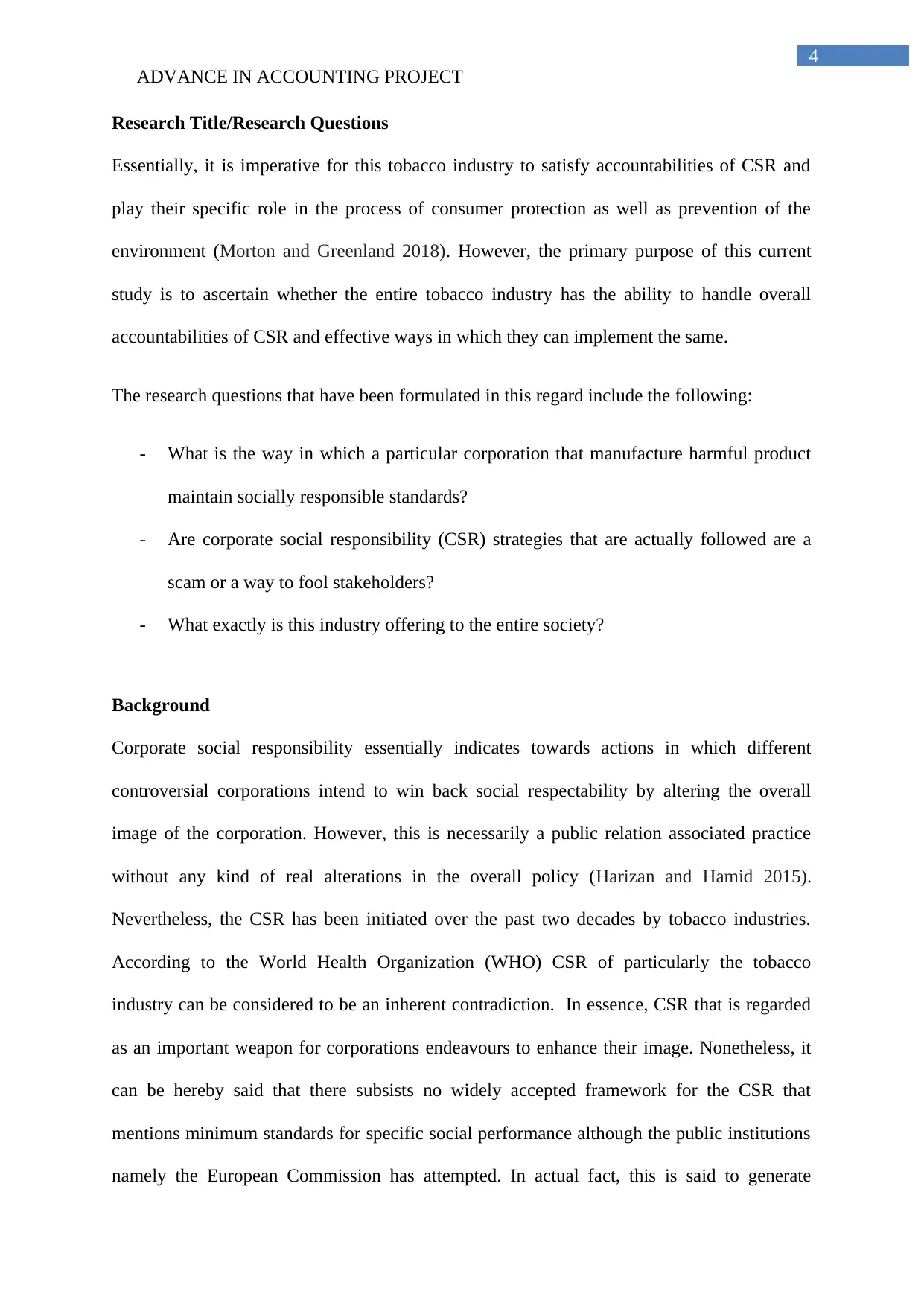
4
ADVANCE IN ACCOUNTING PROJECT
Research Title/Research Questions
Essentially, it is imperative for this tobacco industry to satisfy accountabilities of CSR and
play their specific role in the process of consumer protection as well as prevention of the
environment (Morton and Greenland 2018). However, the primary purpose of this current
study is to ascertain whether the entire tobacco industry has the ability to handle overall
accountabilities of CSR and effective ways in which they can implement the same.
The research questions that have been formulated in this regard include the following:
- What is the way in which a particular corporation that manufacture harmful product
maintain socially responsible standards?
- Are corporate social responsibility (CSR) strategies that are actually followed are a
scam or a way to fool stakeholders?
- What exactly is this industry offering to the entire society?
Background
Corporate social responsibility essentially indicates towards actions in which different
controversial corporations intend to win back social respectability by altering the overall
image of the corporation. However, this is necessarily a public relation associated practice
without any kind of real alterations in the overall policy (Harizan and Hamid 2015).
Nevertheless, the CSR has been initiated over the past two decades by tobacco industries.
According to the World Health Organization (WHO) CSR of particularly the tobacco
industry can be considered to be an inherent contradiction. In essence, CSR that is regarded
as an important weapon for corporations endeavours to enhance their image. Nonetheless, it
can be hereby said that there subsists no widely accepted framework for the CSR that
mentions minimum standards for specific social performance although the public institutions
namely the European Commission has attempted. In actual fact, this is said to generate
ADVANCE IN ACCOUNTING PROJECT
Research Title/Research Questions
Essentially, it is imperative for this tobacco industry to satisfy accountabilities of CSR and
play their specific role in the process of consumer protection as well as prevention of the
environment (Morton and Greenland 2018). However, the primary purpose of this current
study is to ascertain whether the entire tobacco industry has the ability to handle overall
accountabilities of CSR and effective ways in which they can implement the same.
The research questions that have been formulated in this regard include the following:
- What is the way in which a particular corporation that manufacture harmful product
maintain socially responsible standards?
- Are corporate social responsibility (CSR) strategies that are actually followed are a
scam or a way to fool stakeholders?
- What exactly is this industry offering to the entire society?
Background
Corporate social responsibility essentially indicates towards actions in which different
controversial corporations intend to win back social respectability by altering the overall
image of the corporation. However, this is necessarily a public relation associated practice
without any kind of real alterations in the overall policy (Harizan and Hamid 2015).
Nevertheless, the CSR has been initiated over the past two decades by tobacco industries.
According to the World Health Organization (WHO) CSR of particularly the tobacco
industry can be considered to be an inherent contradiction. In essence, CSR that is regarded
as an important weapon for corporations endeavours to enhance their image. Nonetheless, it
can be hereby said that there subsists no widely accepted framework for the CSR that
mentions minimum standards for specific social performance although the public institutions
namely the European Commission has attempted. In actual fact, this is said to generate
Paraphrase This Document
Need a fresh take? Get an instant paraphrase of this document with our AI Paraphraser
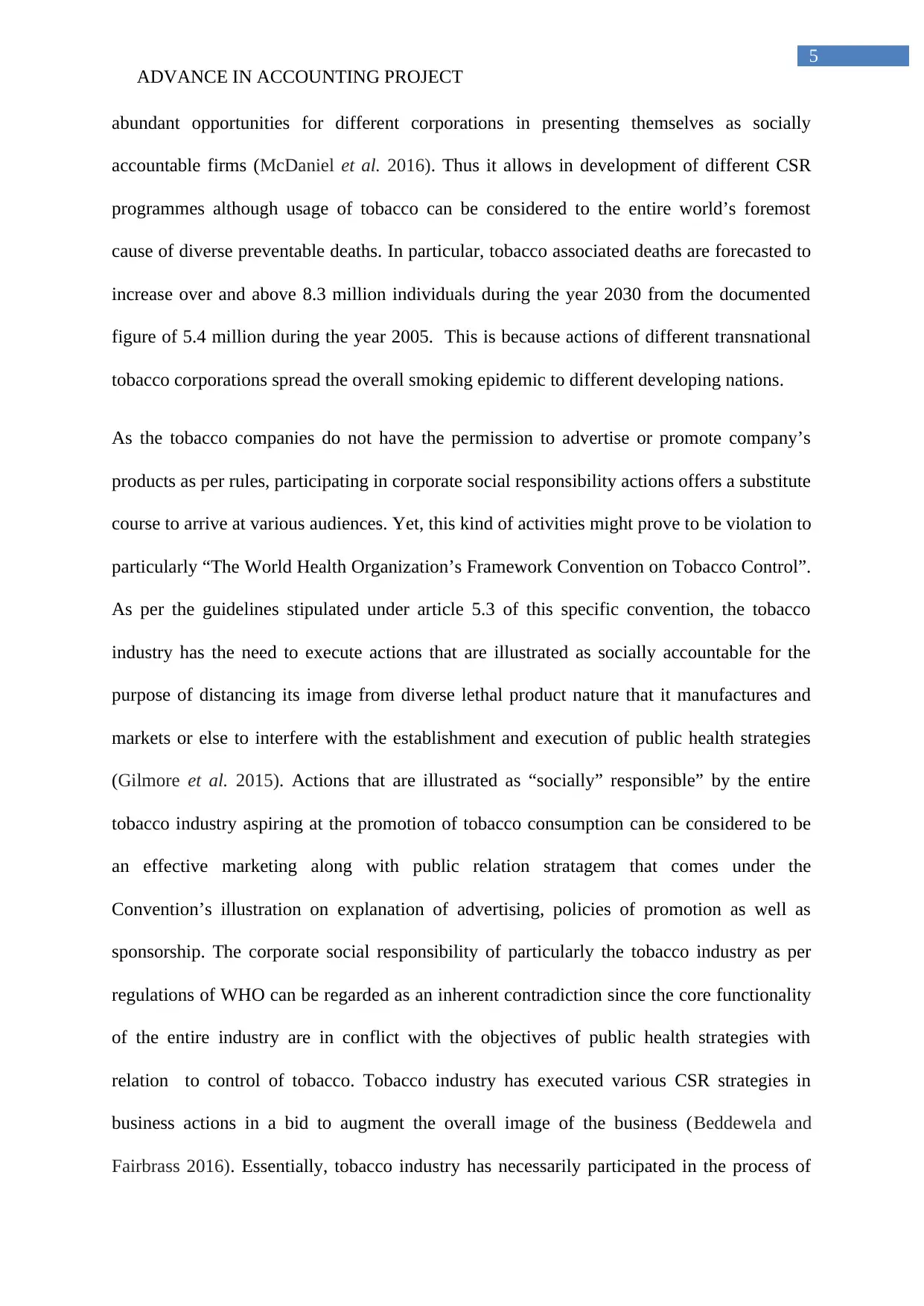
5
ADVANCE IN ACCOUNTING PROJECT
abundant opportunities for different corporations in presenting themselves as socially
accountable firms (McDaniel et al. 2016). Thus it allows in development of different CSR
programmes although usage of tobacco can be considered to the entire world’s foremost
cause of diverse preventable deaths. In particular, tobacco associated deaths are forecasted to
increase over and above 8.3 million individuals during the year 2030 from the documented
figure of 5.4 million during the year 2005. This is because actions of different transnational
tobacco corporations spread the overall smoking epidemic to different developing nations.
As the tobacco companies do not have the permission to advertise or promote company’s
products as per rules, participating in corporate social responsibility actions offers a substitute
course to arrive at various audiences. Yet, this kind of activities might prove to be violation to
particularly “The World Health Organization’s Framework Convention on Tobacco Control”.
As per the guidelines stipulated under article 5.3 of this specific convention, the tobacco
industry has the need to execute actions that are illustrated as socially accountable for the
purpose of distancing its image from diverse lethal product nature that it manufactures and
markets or else to interfere with the establishment and execution of public health strategies
(Gilmore et al. 2015). Actions that are illustrated as “socially” responsible” by the entire
tobacco industry aspiring at the promotion of tobacco consumption can be considered to be
an effective marketing along with public relation stratagem that comes under the
Convention’s illustration on explanation of advertising, policies of promotion as well as
sponsorship. The corporate social responsibility of particularly the tobacco industry as per
regulations of WHO can be regarded as an inherent contradiction since the core functionality
of the entire industry are in conflict with the objectives of public health strategies with
relation to control of tobacco. Tobacco industry has executed various CSR strategies in
business actions in a bid to augment the overall image of the business (Beddewela and
Fairbrass 2016). Essentially, tobacco industry has necessarily participated in the process of
ADVANCE IN ACCOUNTING PROJECT
abundant opportunities for different corporations in presenting themselves as socially
accountable firms (McDaniel et al. 2016). Thus it allows in development of different CSR
programmes although usage of tobacco can be considered to the entire world’s foremost
cause of diverse preventable deaths. In particular, tobacco associated deaths are forecasted to
increase over and above 8.3 million individuals during the year 2030 from the documented
figure of 5.4 million during the year 2005. This is because actions of different transnational
tobacco corporations spread the overall smoking epidemic to different developing nations.
As the tobacco companies do not have the permission to advertise or promote company’s
products as per rules, participating in corporate social responsibility actions offers a substitute
course to arrive at various audiences. Yet, this kind of activities might prove to be violation to
particularly “The World Health Organization’s Framework Convention on Tobacco Control”.
As per the guidelines stipulated under article 5.3 of this specific convention, the tobacco
industry has the need to execute actions that are illustrated as socially accountable for the
purpose of distancing its image from diverse lethal product nature that it manufactures and
markets or else to interfere with the establishment and execution of public health strategies
(Gilmore et al. 2015). Actions that are illustrated as “socially” responsible” by the entire
tobacco industry aspiring at the promotion of tobacco consumption can be considered to be
an effective marketing along with public relation stratagem that comes under the
Convention’s illustration on explanation of advertising, policies of promotion as well as
sponsorship. The corporate social responsibility of particularly the tobacco industry as per
regulations of WHO can be regarded as an inherent contradiction since the core functionality
of the entire industry are in conflict with the objectives of public health strategies with
relation to control of tobacco. Tobacco industry has executed various CSR strategies in
business actions in a bid to augment the overall image of the business (Beddewela and
Fairbrass 2016). Essentially, tobacco industry has necessarily participated in the process of
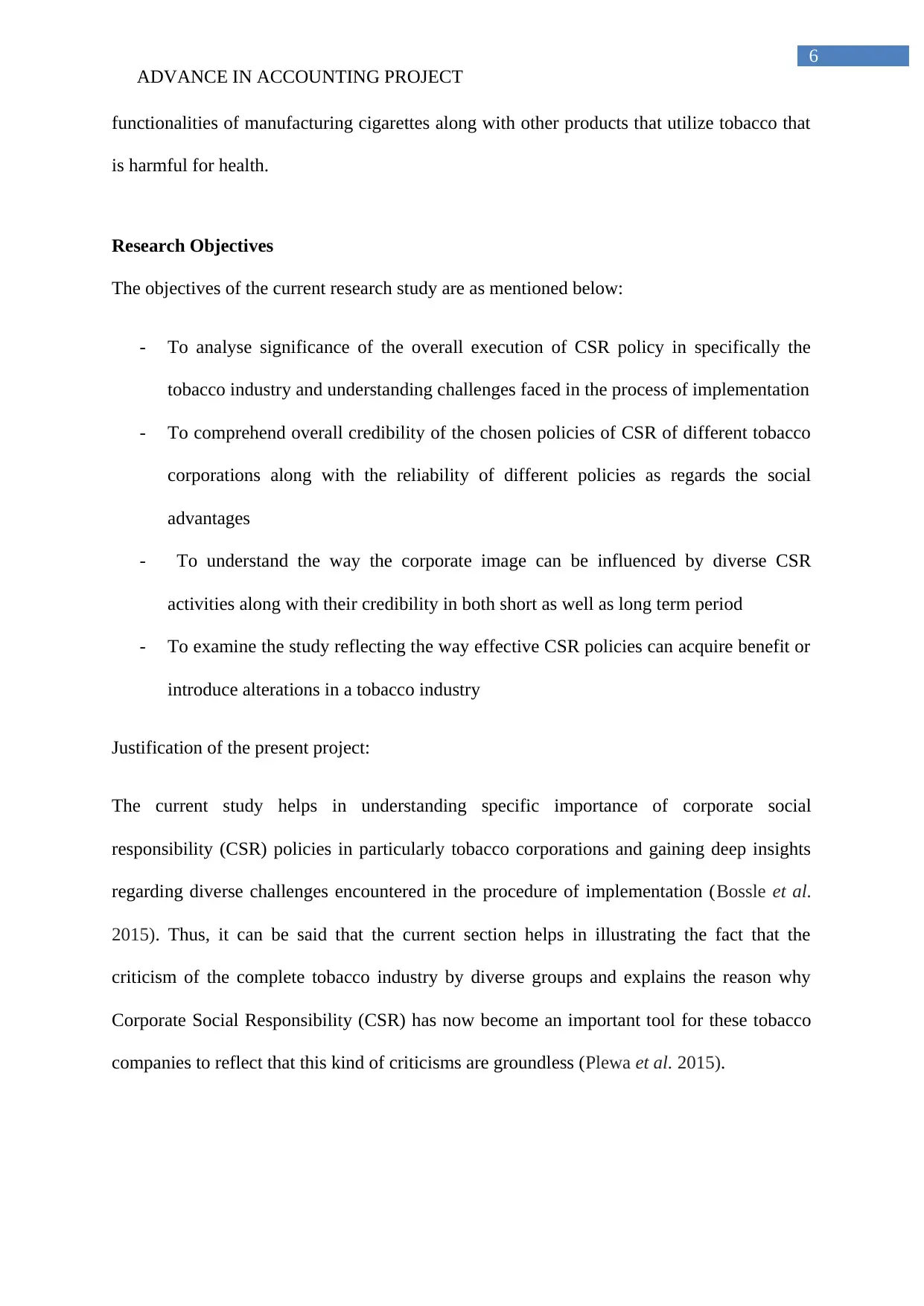
6
ADVANCE IN ACCOUNTING PROJECT
functionalities of manufacturing cigarettes along with other products that utilize tobacco that
is harmful for health.
Research Objectives
The objectives of the current research study are as mentioned below:
- To analyse significance of the overall execution of CSR policy in specifically the
tobacco industry and understanding challenges faced in the process of implementation
- To comprehend overall credibility of the chosen policies of CSR of different tobacco
corporations along with the reliability of different policies as regards the social
advantages
- To understand the way the corporate image can be influenced by diverse CSR
activities along with their credibility in both short as well as long term period
- To examine the study reflecting the way effective CSR policies can acquire benefit or
introduce alterations in a tobacco industry
Justification of the present project:
The current study helps in understanding specific importance of corporate social
responsibility (CSR) policies in particularly tobacco corporations and gaining deep insights
regarding diverse challenges encountered in the procedure of implementation (Bossle et al.
2015). Thus, it can be said that the current section helps in illustrating the fact that the
criticism of the complete tobacco industry by diverse groups and explains the reason why
Corporate Social Responsibility (CSR) has now become an important tool for these tobacco
companies to reflect that this kind of criticisms are groundless (Plewa et al. 2015).
ADVANCE IN ACCOUNTING PROJECT
functionalities of manufacturing cigarettes along with other products that utilize tobacco that
is harmful for health.
Research Objectives
The objectives of the current research study are as mentioned below:
- To analyse significance of the overall execution of CSR policy in specifically the
tobacco industry and understanding challenges faced in the process of implementation
- To comprehend overall credibility of the chosen policies of CSR of different tobacco
corporations along with the reliability of different policies as regards the social
advantages
- To understand the way the corporate image can be influenced by diverse CSR
activities along with their credibility in both short as well as long term period
- To examine the study reflecting the way effective CSR policies can acquire benefit or
introduce alterations in a tobacco industry
Justification of the present project:
The current study helps in understanding specific importance of corporate social
responsibility (CSR) policies in particularly tobacco corporations and gaining deep insights
regarding diverse challenges encountered in the procedure of implementation (Bossle et al.
2015). Thus, it can be said that the current section helps in illustrating the fact that the
criticism of the complete tobacco industry by diverse groups and explains the reason why
Corporate Social Responsibility (CSR) has now become an important tool for these tobacco
companies to reflect that this kind of criticisms are groundless (Plewa et al. 2015).
⊘ This is a preview!⊘
Do you want full access?
Subscribe today to unlock all pages.

Trusted by 1+ million students worldwide
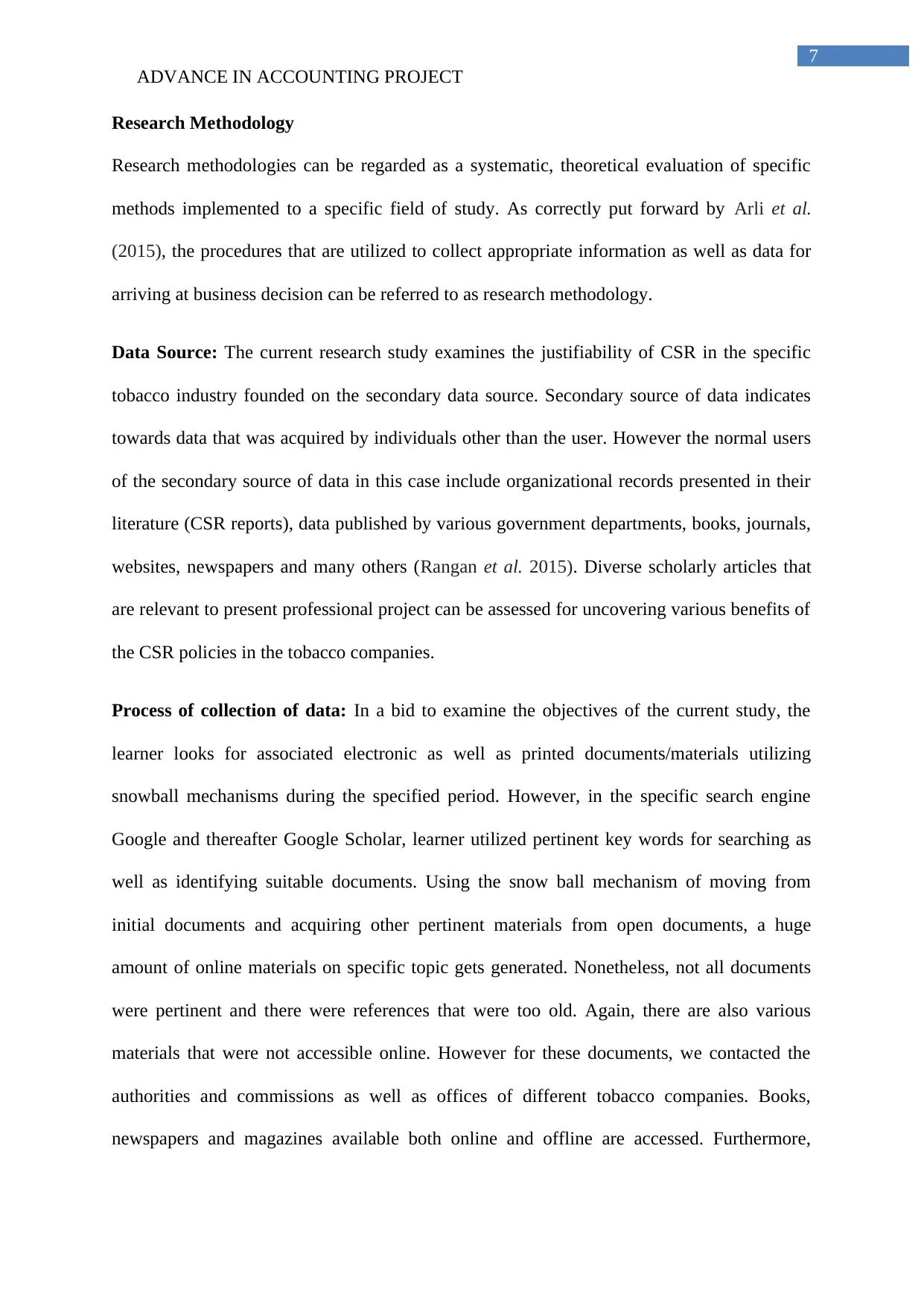
7
ADVANCE IN ACCOUNTING PROJECT
Research Methodology
Research methodologies can be regarded as a systematic, theoretical evaluation of specific
methods implemented to a specific field of study. As correctly put forward by Arli et al.
(2015), the procedures that are utilized to collect appropriate information as well as data for
arriving at business decision can be referred to as research methodology.
Data Source: The current research study examines the justifiability of CSR in the specific
tobacco industry founded on the secondary data source. Secondary source of data indicates
towards data that was acquired by individuals other than the user. However the normal users
of the secondary source of data in this case include organizational records presented in their
literature (CSR reports), data published by various government departments, books, journals,
websites, newspapers and many others (Rangan et al. 2015). Diverse scholarly articles that
are relevant to present professional project can be assessed for uncovering various benefits of
the CSR policies in the tobacco companies.
Process of collection of data: In a bid to examine the objectives of the current study, the
learner looks for associated electronic as well as printed documents/materials utilizing
snowball mechanisms during the specified period. However, in the specific search engine
Google and thereafter Google Scholar, learner utilized pertinent key words for searching as
well as identifying suitable documents. Using the snow ball mechanism of moving from
initial documents and acquiring other pertinent materials from open documents, a huge
amount of online materials on specific topic gets generated. Nonetheless, not all documents
were pertinent and there were references that were too old. Again, there are also various
materials that were not accessible online. However for these documents, we contacted the
authorities and commissions as well as offices of different tobacco companies. Books,
newspapers and magazines available both online and offline are accessed. Furthermore,
ADVANCE IN ACCOUNTING PROJECT
Research Methodology
Research methodologies can be regarded as a systematic, theoretical evaluation of specific
methods implemented to a specific field of study. As correctly put forward by Arli et al.
(2015), the procedures that are utilized to collect appropriate information as well as data for
arriving at business decision can be referred to as research methodology.
Data Source: The current research study examines the justifiability of CSR in the specific
tobacco industry founded on the secondary data source. Secondary source of data indicates
towards data that was acquired by individuals other than the user. However the normal users
of the secondary source of data in this case include organizational records presented in their
literature (CSR reports), data published by various government departments, books, journals,
websites, newspapers and many others (Rangan et al. 2015). Diverse scholarly articles that
are relevant to present professional project can be assessed for uncovering various benefits of
the CSR policies in the tobacco companies.
Process of collection of data: In a bid to examine the objectives of the current study, the
learner looks for associated electronic as well as printed documents/materials utilizing
snowball mechanisms during the specified period. However, in the specific search engine
Google and thereafter Google Scholar, learner utilized pertinent key words for searching as
well as identifying suitable documents. Using the snow ball mechanism of moving from
initial documents and acquiring other pertinent materials from open documents, a huge
amount of online materials on specific topic gets generated. Nonetheless, not all documents
were pertinent and there were references that were too old. Again, there are also various
materials that were not accessible online. However for these documents, we contacted the
authorities and commissions as well as offices of different tobacco companies. Books,
newspapers and magazines available both online and offline are accessed. Furthermore,
Paraphrase This Document
Need a fresh take? Get an instant paraphrase of this document with our AI Paraphraser
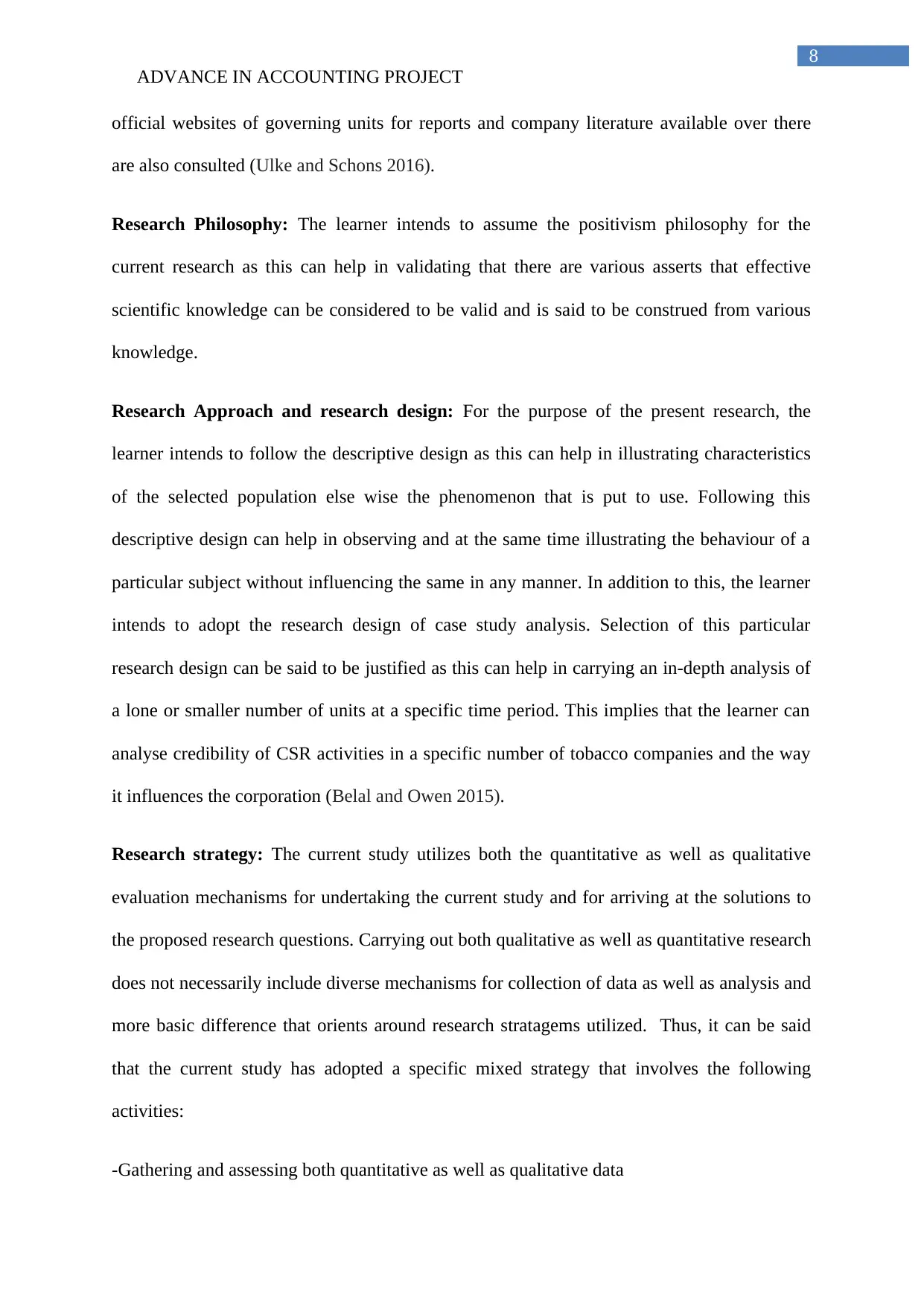
8
ADVANCE IN ACCOUNTING PROJECT
official websites of governing units for reports and company literature available over there
are also consulted (Ulke and Schons 2016).
Research Philosophy: The learner intends to assume the positivism philosophy for the
current research as this can help in validating that there are various asserts that effective
scientific knowledge can be considered to be valid and is said to be construed from various
knowledge.
Research Approach and research design: For the purpose of the present research, the
learner intends to follow the descriptive design as this can help in illustrating characteristics
of the selected population else wise the phenomenon that is put to use. Following this
descriptive design can help in observing and at the same time illustrating the behaviour of a
particular subject without influencing the same in any manner. In addition to this, the learner
intends to adopt the research design of case study analysis. Selection of this particular
research design can be said to be justified as this can help in carrying an in-depth analysis of
a lone or smaller number of units at a specific time period. This implies that the learner can
analyse credibility of CSR activities in a specific number of tobacco companies and the way
it influences the corporation (Belal and Owen 2015).
Research strategy: The current study utilizes both the quantitative as well as qualitative
evaluation mechanisms for undertaking the current study and for arriving at the solutions to
the proposed research questions. Carrying out both qualitative as well as quantitative research
does not necessarily include diverse mechanisms for collection of data as well as analysis and
more basic difference that orients around research stratagems utilized. Thus, it can be said
that the current study has adopted a specific mixed strategy that involves the following
activities:
-Gathering and assessing both quantitative as well as qualitative data
ADVANCE IN ACCOUNTING PROJECT
official websites of governing units for reports and company literature available over there
are also consulted (Ulke and Schons 2016).
Research Philosophy: The learner intends to assume the positivism philosophy for the
current research as this can help in validating that there are various asserts that effective
scientific knowledge can be considered to be valid and is said to be construed from various
knowledge.
Research Approach and research design: For the purpose of the present research, the
learner intends to follow the descriptive design as this can help in illustrating characteristics
of the selected population else wise the phenomenon that is put to use. Following this
descriptive design can help in observing and at the same time illustrating the behaviour of a
particular subject without influencing the same in any manner. In addition to this, the learner
intends to adopt the research design of case study analysis. Selection of this particular
research design can be said to be justified as this can help in carrying an in-depth analysis of
a lone or smaller number of units at a specific time period. This implies that the learner can
analyse credibility of CSR activities in a specific number of tobacco companies and the way
it influences the corporation (Belal and Owen 2015).
Research strategy: The current study utilizes both the quantitative as well as qualitative
evaluation mechanisms for undertaking the current study and for arriving at the solutions to
the proposed research questions. Carrying out both qualitative as well as quantitative research
does not necessarily include diverse mechanisms for collection of data as well as analysis and
more basic difference that orients around research stratagems utilized. Thus, it can be said
that the current study has adopted a specific mixed strategy that involves the following
activities:
-Gathering and assessing both quantitative as well as qualitative data
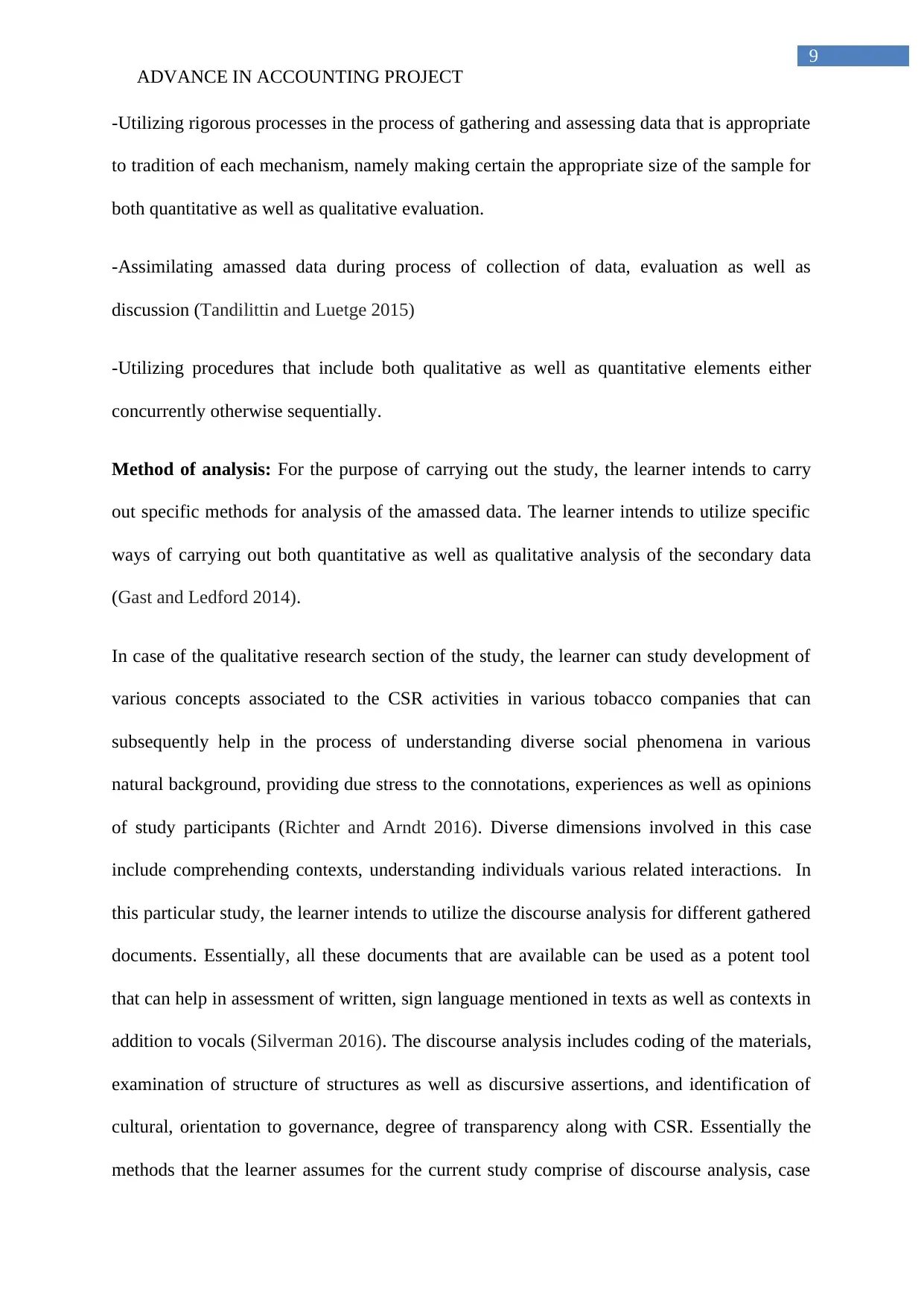
9
ADVANCE IN ACCOUNTING PROJECT
-Utilizing rigorous processes in the process of gathering and assessing data that is appropriate
to tradition of each mechanism, namely making certain the appropriate size of the sample for
both quantitative as well as qualitative evaluation.
-Assimilating amassed data during process of collection of data, evaluation as well as
discussion (Tandilittin and Luetge 2015)
-Utilizing procedures that include both qualitative as well as quantitative elements either
concurrently otherwise sequentially.
Method of analysis: For the purpose of carrying out the study, the learner intends to carry
out specific methods for analysis of the amassed data. The learner intends to utilize specific
ways of carrying out both quantitative as well as qualitative analysis of the secondary data
(Gast and Ledford 2014).
In case of the qualitative research section of the study, the learner can study development of
various concepts associated to the CSR activities in various tobacco companies that can
subsequently help in the process of understanding diverse social phenomena in various
natural background, providing due stress to the connotations, experiences as well as opinions
of study participants (Richter and Arndt 2016). Diverse dimensions involved in this case
include comprehending contexts, understanding individuals various related interactions. In
this particular study, the learner intends to utilize the discourse analysis for different gathered
documents. Essentially, all these documents that are available can be used as a potent tool
that can help in assessment of written, sign language mentioned in texts as well as contexts in
addition to vocals (Silverman 2016). The discourse analysis includes coding of the materials,
examination of structure of structures as well as discursive assertions, and identification of
cultural, orientation to governance, degree of transparency along with CSR. Essentially the
methods that the learner assumes for the current study comprise of discourse analysis, case
ADVANCE IN ACCOUNTING PROJECT
-Utilizing rigorous processes in the process of gathering and assessing data that is appropriate
to tradition of each mechanism, namely making certain the appropriate size of the sample for
both quantitative as well as qualitative evaluation.
-Assimilating amassed data during process of collection of data, evaluation as well as
discussion (Tandilittin and Luetge 2015)
-Utilizing procedures that include both qualitative as well as quantitative elements either
concurrently otherwise sequentially.
Method of analysis: For the purpose of carrying out the study, the learner intends to carry
out specific methods for analysis of the amassed data. The learner intends to utilize specific
ways of carrying out both quantitative as well as qualitative analysis of the secondary data
(Gast and Ledford 2014).
In case of the qualitative research section of the study, the learner can study development of
various concepts associated to the CSR activities in various tobacco companies that can
subsequently help in the process of understanding diverse social phenomena in various
natural background, providing due stress to the connotations, experiences as well as opinions
of study participants (Richter and Arndt 2016). Diverse dimensions involved in this case
include comprehending contexts, understanding individuals various related interactions. In
this particular study, the learner intends to utilize the discourse analysis for different gathered
documents. Essentially, all these documents that are available can be used as a potent tool
that can help in assessment of written, sign language mentioned in texts as well as contexts in
addition to vocals (Silverman 2016). The discourse analysis includes coding of the materials,
examination of structure of structures as well as discursive assertions, and identification of
cultural, orientation to governance, degree of transparency along with CSR. Essentially the
methods that the learner assumes for the current study comprise of discourse analysis, case
⊘ This is a preview!⊘
Do you want full access?
Subscribe today to unlock all pages.

Trusted by 1+ million students worldwide
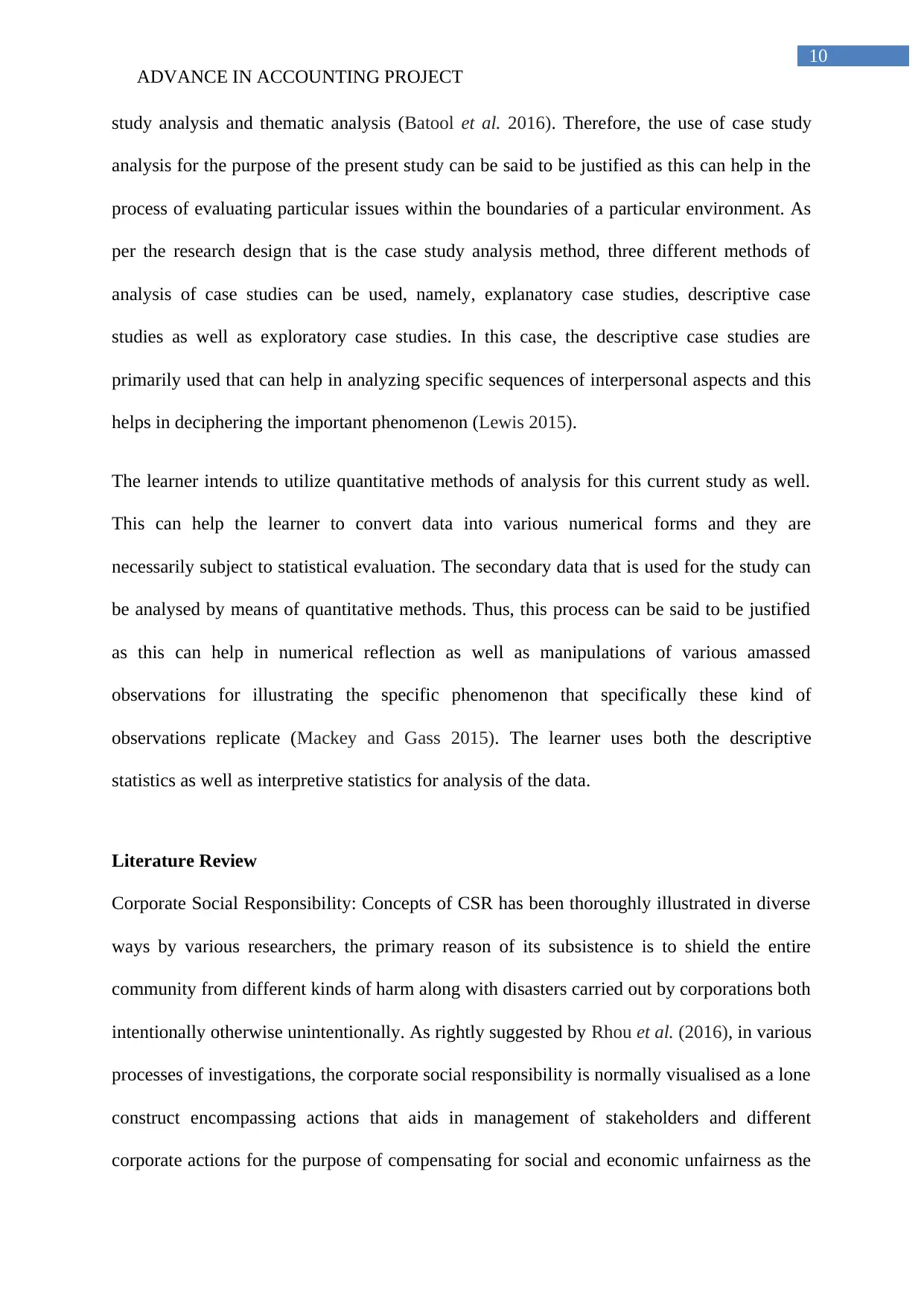
10
ADVANCE IN ACCOUNTING PROJECT
study analysis and thematic analysis (Batool et al. 2016). Therefore, the use of case study
analysis for the purpose of the present study can be said to be justified as this can help in the
process of evaluating particular issues within the boundaries of a particular environment. As
per the research design that is the case study analysis method, three different methods of
analysis of case studies can be used, namely, explanatory case studies, descriptive case
studies as well as exploratory case studies. In this case, the descriptive case studies are
primarily used that can help in analyzing specific sequences of interpersonal aspects and this
helps in deciphering the important phenomenon (Lewis 2015).
The learner intends to utilize quantitative methods of analysis for this current study as well.
This can help the learner to convert data into various numerical forms and they are
necessarily subject to statistical evaluation. The secondary data that is used for the study can
be analysed by means of quantitative methods. Thus, this process can be said to be justified
as this can help in numerical reflection as well as manipulations of various amassed
observations for illustrating the specific phenomenon that specifically these kind of
observations replicate (Mackey and Gass 2015). The learner uses both the descriptive
statistics as well as interpretive statistics for analysis of the data.
Literature Review
Corporate Social Responsibility: Concepts of CSR has been thoroughly illustrated in diverse
ways by various researchers, the primary reason of its subsistence is to shield the entire
community from different kinds of harm along with disasters carried out by corporations both
intentionally otherwise unintentionally. As rightly suggested by Rhou et al. (2016), in various
processes of investigations, the corporate social responsibility is normally visualised as a lone
construct encompassing actions that aids in management of stakeholders and different
corporate actions for the purpose of compensating for social and economic unfairness as the
ADVANCE IN ACCOUNTING PROJECT
study analysis and thematic analysis (Batool et al. 2016). Therefore, the use of case study
analysis for the purpose of the present study can be said to be justified as this can help in the
process of evaluating particular issues within the boundaries of a particular environment. As
per the research design that is the case study analysis method, three different methods of
analysis of case studies can be used, namely, explanatory case studies, descriptive case
studies as well as exploratory case studies. In this case, the descriptive case studies are
primarily used that can help in analyzing specific sequences of interpersonal aspects and this
helps in deciphering the important phenomenon (Lewis 2015).
The learner intends to utilize quantitative methods of analysis for this current study as well.
This can help the learner to convert data into various numerical forms and they are
necessarily subject to statistical evaluation. The secondary data that is used for the study can
be analysed by means of quantitative methods. Thus, this process can be said to be justified
as this can help in numerical reflection as well as manipulations of various amassed
observations for illustrating the specific phenomenon that specifically these kind of
observations replicate (Mackey and Gass 2015). The learner uses both the descriptive
statistics as well as interpretive statistics for analysis of the data.
Literature Review
Corporate Social Responsibility: Concepts of CSR has been thoroughly illustrated in diverse
ways by various researchers, the primary reason of its subsistence is to shield the entire
community from different kinds of harm along with disasters carried out by corporations both
intentionally otherwise unintentionally. As rightly suggested by Rhou et al. (2016), in various
processes of investigations, the corporate social responsibility is normally visualised as a lone
construct encompassing actions that aids in management of stakeholders and different
corporate actions for the purpose of compensating for social and economic unfairness as the
Paraphrase This Document
Need a fresh take? Get an instant paraphrase of this document with our AI Paraphraser
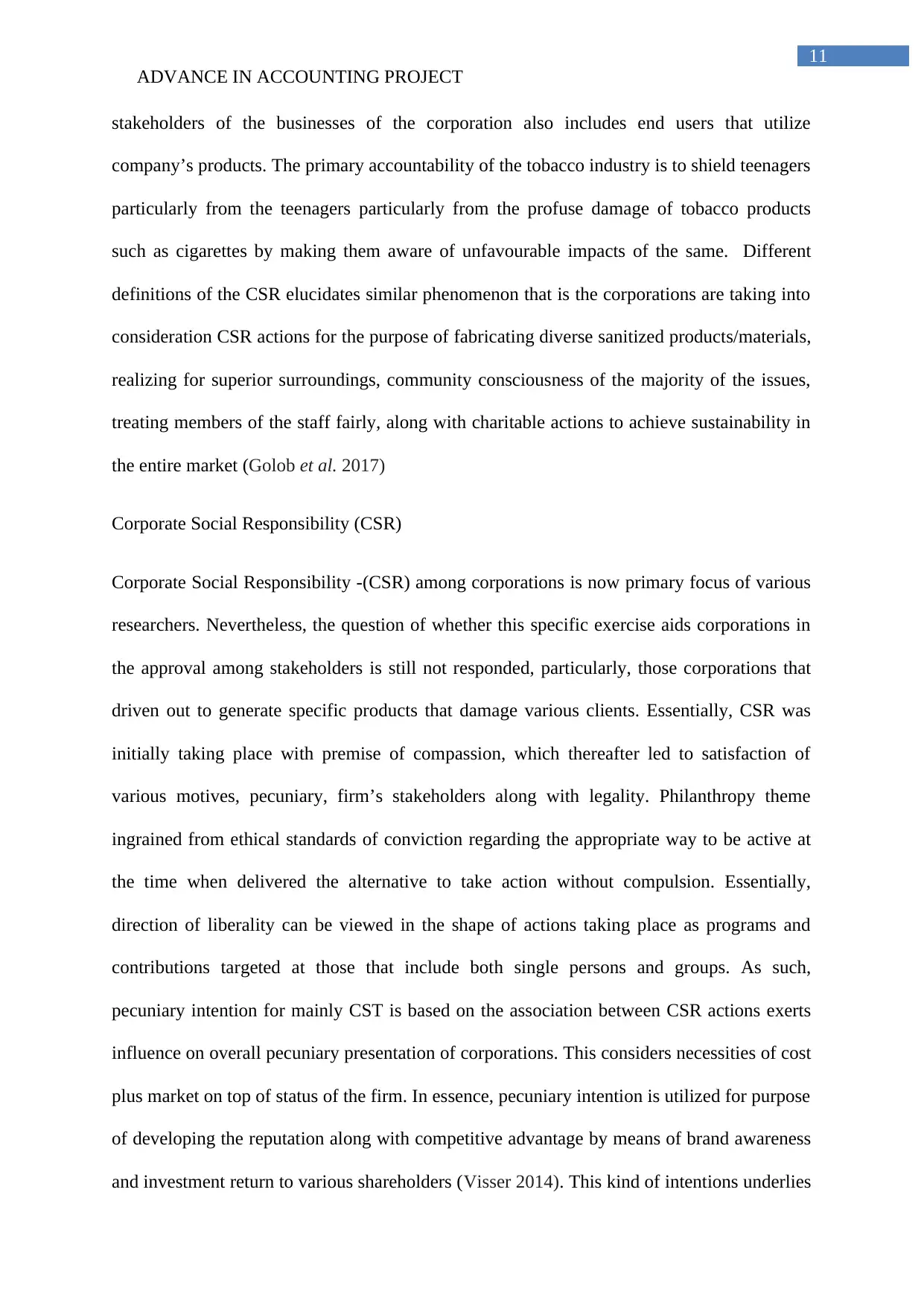
11
ADVANCE IN ACCOUNTING PROJECT
stakeholders of the businesses of the corporation also includes end users that utilize
company’s products. The primary accountability of the tobacco industry is to shield teenagers
particularly from the teenagers particularly from the profuse damage of tobacco products
such as cigarettes by making them aware of unfavourable impacts of the same. Different
definitions of the CSR elucidates similar phenomenon that is the corporations are taking into
consideration CSR actions for the purpose of fabricating diverse sanitized products/materials,
realizing for superior surroundings, community consciousness of the majority of the issues,
treating members of the staff fairly, along with charitable actions to achieve sustainability in
the entire market (Golob et al. 2017)
Corporate Social Responsibility (CSR)
Corporate Social Responsibility -(CSR) among corporations is now primary focus of various
researchers. Nevertheless, the question of whether this specific exercise aids corporations in
the approval among stakeholders is still not responded, particularly, those corporations that
driven out to generate specific products that damage various clients. Essentially, CSR was
initially taking place with premise of compassion, which thereafter led to satisfaction of
various motives, pecuniary, firm’s stakeholders along with legality. Philanthropy theme
ingrained from ethical standards of conviction regarding the appropriate way to be active at
the time when delivered the alternative to take action without compulsion. Essentially,
direction of liberality can be viewed in the shape of actions taking place as programs and
contributions targeted at those that include both single persons and groups. As such,
pecuniary intention for mainly CST is based on the association between CSR actions exerts
influence on overall pecuniary presentation of corporations. This considers necessities of cost
plus market on top of status of the firm. In essence, pecuniary intention is utilized for purpose
of developing the reputation along with competitive advantage by means of brand awareness
and investment return to various shareholders (Visser 2014). This kind of intentions underlies
ADVANCE IN ACCOUNTING PROJECT
stakeholders of the businesses of the corporation also includes end users that utilize
company’s products. The primary accountability of the tobacco industry is to shield teenagers
particularly from the teenagers particularly from the profuse damage of tobacco products
such as cigarettes by making them aware of unfavourable impacts of the same. Different
definitions of the CSR elucidates similar phenomenon that is the corporations are taking into
consideration CSR actions for the purpose of fabricating diverse sanitized products/materials,
realizing for superior surroundings, community consciousness of the majority of the issues,
treating members of the staff fairly, along with charitable actions to achieve sustainability in
the entire market (Golob et al. 2017)
Corporate Social Responsibility (CSR)
Corporate Social Responsibility -(CSR) among corporations is now primary focus of various
researchers. Nevertheless, the question of whether this specific exercise aids corporations in
the approval among stakeholders is still not responded, particularly, those corporations that
driven out to generate specific products that damage various clients. Essentially, CSR was
initially taking place with premise of compassion, which thereafter led to satisfaction of
various motives, pecuniary, firm’s stakeholders along with legality. Philanthropy theme
ingrained from ethical standards of conviction regarding the appropriate way to be active at
the time when delivered the alternative to take action without compulsion. Essentially,
direction of liberality can be viewed in the shape of actions taking place as programs and
contributions targeted at those that include both single persons and groups. As such,
pecuniary intention for mainly CST is based on the association between CSR actions exerts
influence on overall pecuniary presentation of corporations. This considers necessities of cost
plus market on top of status of the firm. In essence, pecuniary intention is utilized for purpose
of developing the reputation along with competitive advantage by means of brand awareness
and investment return to various shareholders (Visser 2014). This kind of intentions underlies
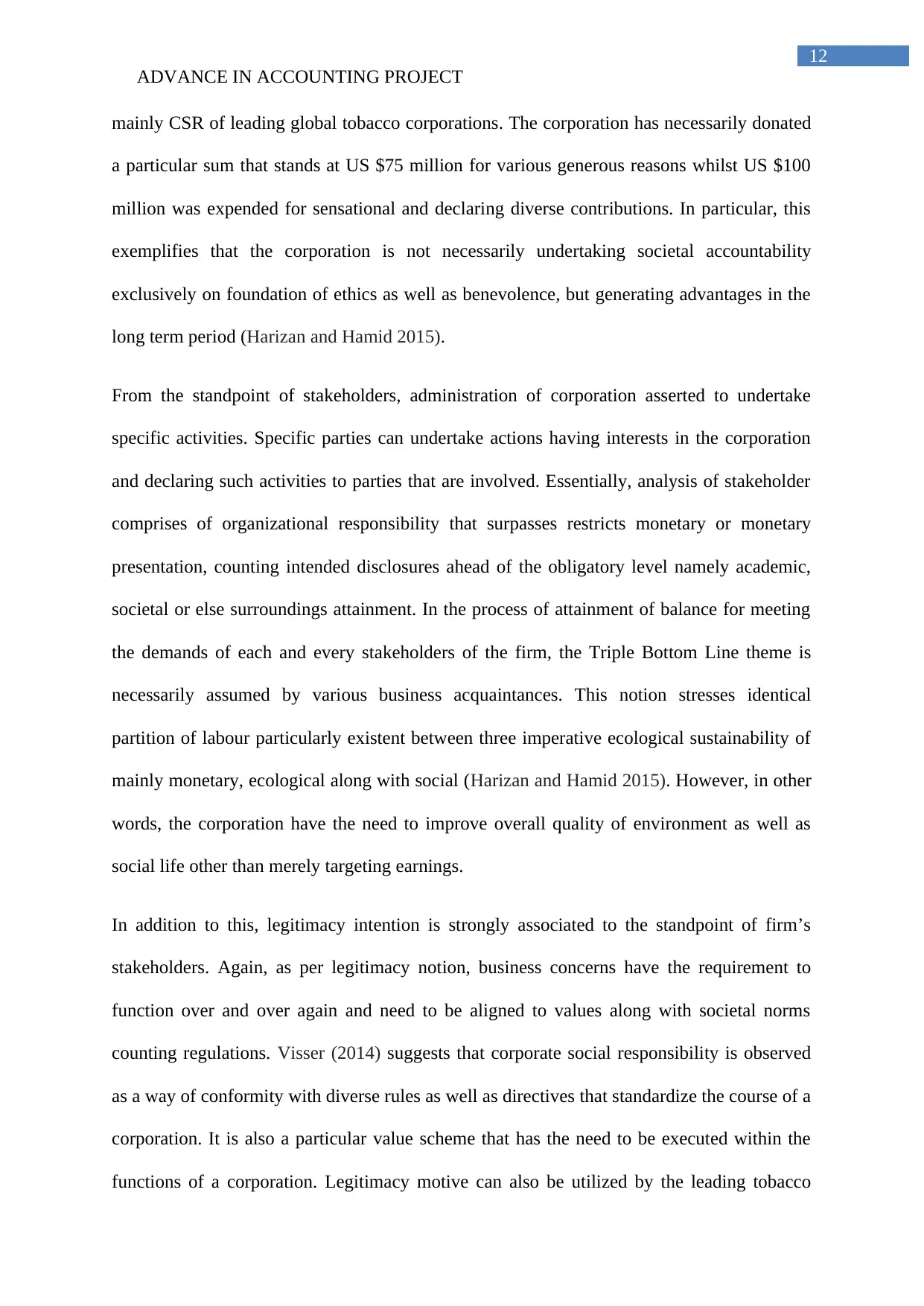
12
ADVANCE IN ACCOUNTING PROJECT
mainly CSR of leading global tobacco corporations. The corporation has necessarily donated
a particular sum that stands at US $75 million for various generous reasons whilst US $100
million was expended for sensational and declaring diverse contributions. In particular, this
exemplifies that the corporation is not necessarily undertaking societal accountability
exclusively on foundation of ethics as well as benevolence, but generating advantages in the
long term period (Harizan and Hamid 2015).
From the standpoint of stakeholders, administration of corporation asserted to undertake
specific activities. Specific parties can undertake actions having interests in the corporation
and declaring such activities to parties that are involved. Essentially, analysis of stakeholder
comprises of organizational responsibility that surpasses restricts monetary or monetary
presentation, counting intended disclosures ahead of the obligatory level namely academic,
societal or else surroundings attainment. In the process of attainment of balance for meeting
the demands of each and every stakeholders of the firm, the Triple Bottom Line theme is
necessarily assumed by various business acquaintances. This notion stresses identical
partition of labour particularly existent between three imperative ecological sustainability of
mainly monetary, ecological along with social (Harizan and Hamid 2015). However, in other
words, the corporation have the need to improve overall quality of environment as well as
social life other than merely targeting earnings.
In addition to this, legitimacy intention is strongly associated to the standpoint of firm’s
stakeholders. Again, as per legitimacy notion, business concerns have the requirement to
function over and over again and need to be aligned to values along with societal norms
counting regulations. Visser (2014) suggests that corporate social responsibility is observed
as a way of conformity with diverse rules as well as directives that standardize the course of a
corporation. It is also a particular value scheme that has the need to be executed within the
functions of a corporation. Legitimacy motive can also be utilized by the leading tobacco
ADVANCE IN ACCOUNTING PROJECT
mainly CSR of leading global tobacco corporations. The corporation has necessarily donated
a particular sum that stands at US $75 million for various generous reasons whilst US $100
million was expended for sensational and declaring diverse contributions. In particular, this
exemplifies that the corporation is not necessarily undertaking societal accountability
exclusively on foundation of ethics as well as benevolence, but generating advantages in the
long term period (Harizan and Hamid 2015).
From the standpoint of stakeholders, administration of corporation asserted to undertake
specific activities. Specific parties can undertake actions having interests in the corporation
and declaring such activities to parties that are involved. Essentially, analysis of stakeholder
comprises of organizational responsibility that surpasses restricts monetary or monetary
presentation, counting intended disclosures ahead of the obligatory level namely academic,
societal or else surroundings attainment. In the process of attainment of balance for meeting
the demands of each and every stakeholders of the firm, the Triple Bottom Line theme is
necessarily assumed by various business acquaintances. This notion stresses identical
partition of labour particularly existent between three imperative ecological sustainability of
mainly monetary, ecological along with social (Harizan and Hamid 2015). However, in other
words, the corporation have the need to improve overall quality of environment as well as
social life other than merely targeting earnings.
In addition to this, legitimacy intention is strongly associated to the standpoint of firm’s
stakeholders. Again, as per legitimacy notion, business concerns have the requirement to
function over and over again and need to be aligned to values along with societal norms
counting regulations. Visser (2014) suggests that corporate social responsibility is observed
as a way of conformity with diverse rules as well as directives that standardize the course of a
corporation. It is also a particular value scheme that has the need to be executed within the
functions of a corporation. Legitimacy motive can also be utilized by the leading tobacco
⊘ This is a preview!⊘
Do you want full access?
Subscribe today to unlock all pages.

Trusted by 1+ million students worldwide
1 out of 19
Related Documents
Your All-in-One AI-Powered Toolkit for Academic Success.
+13062052269
info@desklib.com
Available 24*7 on WhatsApp / Email
![[object Object]](/_next/static/media/star-bottom.7253800d.svg)
Unlock your academic potential
Copyright © 2020–2025 A2Z Services. All Rights Reserved. Developed and managed by ZUCOL.





